Electrochemically Obtained Poly(3,4-ethylenedioxythiophene) Layers for Electroanalytical Determination of Lipoic Acid
Abstract
:1. Introduction
2. Materials and Methods
2.1. Experimental Set-Up
2.2. Synthesis of PEDOT Coatings
2.3. Electro-Oxidation of ALA
3. Results and Discussion
3.1. Electrochemical Synthesis of the PEDOT Coatings
3.2. Voltammetric Measurements in the Presence of ALA
3.3. DPV Measurements in the Presence of ALA
4. Conclusions
Author Contributions
Funding
Institutional Review Board Statement
Informed Consent Statement
Data Availability Statement
Acknowledgments
Conflicts of Interest
References
- Inzelt, G. Conducting Polymers: A New Era in Electrochemistry; Springer: Berlin/Heidelberg, Germany, 2012. [Google Scholar]
- Ouyang, J. Application of intrinsically conducting polymers in flexible electronics. SmartMat 2021, 2, 263. [Google Scholar] [CrossRef]
- Bobacka, J.; Ivaska, A. Chemical sensors based on conducting polymers. In Electropolymerization. Concepts, Materials, Applications; Cosnier, S., Karyakin, A., Eds.; Wiley: Weinheim, Germany, 2010; pp. 173–188. [Google Scholar]
- Tsakova, V. Conducting polymers in electroanalytical medical applications. In Applications of Electrochemistry in Medicine, Modern Aspects of Electrochemistry; Schlesinger, M., Ed.; Springer Science + Business Media: New York, NY, USA, 2013; Volume 56, pp. 283–342. [Google Scholar]
- Tezakati, T.; Seifalian, A.; Tan, A.; Seifalian, A.M. Conductive Polymers: Opportunities and Challenges in Biomedical Applications. Chem. Rev. 2018, 118, 6766. [Google Scholar] [CrossRef] [PubMed]
- Ramanavicius, S.; Ramanavicius, A. Conducting polymers in the Design of Biosensors and Biofuel Cells (Review). Polymers 2021, 13, 49. [Google Scholar] [CrossRef] [PubMed]
- Xu, H.; Zhang, J. A Review on Conducting Polymers and Nanopolymer Composite Coatings for Steel Corrosion Protection. Coatings 2019, 9, 807. [Google Scholar] [CrossRef]
- Umoren, S.A.; Solomon, M.M. Protective polymeric films for industrial substrates: A critical review on past and recent applications with conducting polymers and polymer composites/nanocomposites. Progr. Mat. Sci. 2019, 104, 38. [Google Scholar] [CrossRef]
- Zhao, Z.; Xia, K.; Hou, Y.; Zhang, Q.; Yead, Z.; Lu, J. Designing flexible, smart and self-sustainable supercapacitors for portable/wearable electronics: From conductive polymers. Chem. Soc. Rev. 2021, 50, 12702–12743. [Google Scholar] [CrossRef] [PubMed]
- Groenendaal, L.; Jonas, F.; Freitag, D.; Pielartzik, H.; Reynolds, J.R. Poly(3,4-ethylenedioxythiophene) and its derivatives: Past, present, and future. Adv. Mater. 2000, 12, 481–494. [Google Scholar] [CrossRef]
- Elschner, A.; Kirchmeyer, S.; Lovenich, W.; Merker, U.; Reuter, K. PEDOT: Principles and Applications of an Intrinsically Conductive Polymer; CRC Press: Boca Raton, FL, USA, 2010. [Google Scholar]
- Nasybulin, E.; Wei, S.; Kymissis, I.; Levon, K. Effect of solubilizing agent on properties of poly(3,4-ethylenedioxythiophene) (PEDOT) electrodeposited from aqueous solution. Electrochim. Acta 2012, 78, 638. [Google Scholar] [CrossRef]
- Lyutov, V.; Efimov, I.; Bund, A.; Tsakova, V. Electrochemical polymerization of 3,4-ethylenedioxythiophene in the presence of dodecylsulfate and polysulfonic anions—An acoustic impedance study. Electrochim. Acta 2014, 122, 21. [Google Scholar] [CrossRef]
- Lyutov, V.; Gruia, V.; Efimov, I.; Bund, A.; Tsakova, V. An acoustic impedance study of PEDOT layers obtained in aqueous solution. Electrochim. Acta 2016, 190, 285. [Google Scholar] [CrossRef]
- Gribkova, O.L.; Iakobson, O.D.; Nekrasov, A.A.; Cabanova, V.A.; Tverskoy, V.A.; Vannikov, A.V. The influence of polyacid nature on poly(3,4-ethylenedioxythiophene) electrosynthesis and its spectroelectrochemical properties. J. Solid State Electrochem. 2016, 20, 2991. [Google Scholar] [CrossRef]
- Lyutov, V.; Kabanova, V.; Gribkova, O.; Nekrasov, A.; Tsakova, V. Electrochemically Obtained Polysulfonates Doped Poly(3,4-ethylenedioxythiophene) Films—Effects of the Dopant’s Chain Flexibility and Molecular Weight Studied by Electrochemical, Microgravimetric and XPS Methods. Polymers 2021, 13, 2438. [Google Scholar] [CrossRef] [PubMed]
- Gueyea, M.N.; Carella, A.; Faure-Vincent, J.; Demadrillec, R.; Simonato, J.-P. Progress in understanding structure and transport properties of PEDOT-based materials: A critical review. Progr. Mater. Sci. 2020, 108, 100616. [Google Scholar] [CrossRef]
- Ziyatdinova, G.K.; Budnikov, G.K.; Pogoreltsev, V.I. Electrochemical determination of lipoic acid. J. Analyt. Chem. 2004, 59, 288. [Google Scholar] [CrossRef]
- Corduneanu, O.; Garnett, M.; Oliveira Brett, A.M. Anodic Oxidation of a-Lipoic Acid at a Glassy Carbon Electrode and Its Determination in Dietary Supplements. Analyt. Lett. 2007, 40, 1763. [Google Scholar] [CrossRef]
- Skorupa, A.; Michalkiewicz, S. Anodic Oxidation of α-Lipoic Acid on Carbon Electrodes in Acetic Acid—Acetonitrile Solutions, Int. J. Electrochem. Sci. 2019, 14, 5107. [Google Scholar] [CrossRef]
- Ferreira, A.P.M.; dos Santos Pereira, L.N.; Santos da Silva, I.; Tanaka, S.M.C.N.; Tanaka, A.A.; Angnes, L. Determination of a-Lipoic acid on a Pyrolytic Graphite Electrode Modified with Cobalt Phthalocyanine. Electroanalysis 2014, 26, 2138. [Google Scholar] [CrossRef]
- Stankovic, D.M.; Mehmeti, E.; Kalcher, K. Development of sensitive electroanalytical approach for the quantification of α-lipoic acid using boron doped diamond. Analyt. Sci. 2016, 32, 847. [Google Scholar] [CrossRef]
- Ziyatdinova, G.K.; Grigoreva, L.V.; Budnikov, G.K. Electrochemical Determination of Unithiol and Lipoic Acid at Electrodes Modified with Carbon Nanotubes. J. Analyt. Chem. 2009, 64, 185. [Google Scholar] [CrossRef]
- Miranda, M.P.; del Rio, R.; del Valle, M.A.; Faundez, M.; Armijo, F. Use of fluorine-doped tin oxide electrodes for lipoic acid determination in dietary supplements. J. Electroanal. Chem. 2012, 668, 1. [Google Scholar] [CrossRef]
- Marin, M.; Lete, C.; Manolescu, B.N.; Lupu, S. Electrochemical determination of a-lipoic acid in human serum at platinum electrode. J. Electroanal. Chem. 2014, 729, 128. [Google Scholar] [CrossRef]
- Sasikumara, R.; Ranganathan, P.; Chen, S.-M.; Rwei, S.-P. f-MWCNTs-PIN/Ti2O3 nanocomposite: Preparation, characterization and nanomolar detection of α-Lipoic acid in vegetables. Sens. Actuators B 2018, 255, 217. [Google Scholar] [CrossRef]
- Ziyatdinova, G.; Antonova, T.; Vorobev, V.; Osin, Y.; Budnikov, H. Selective voltammetric determination of α-lipoic acid on the electrode modified with SnO2 nanoparticles and cetyltriphenylphosphonium bromide. Monatshefte Für Chem.-Hemical Mon. 2019, 150, 401. [Google Scholar] [CrossRef]
- Saha, M.; Ahammad, H.; Bhoumik, N.; Shakil, S.; Shavan, M.; Morshed, M.; Hossan, T.; Sarker, S.; Rahman, N.; Rahman, S.; et al. Extraction and estimation of alpha lipoic acid content in different food samples by reverse phase HPLC: Effect of heat treatment. Int. J. Biosci. 2018, 13, 473. [Google Scholar]
- Amenta, F.; Traini, E.; Tomassoni, D.; Mignini, F. Pharmacokinetics of Different Formulations of Tioctic (Alpha-Lipoic) Acid in Healthy Volunteers. Clin. Exp. Hypertens. 2008, 30, 767. [Google Scholar] [CrossRef]
- Shay, K.; Moreau, R.; Smith, E.; Smith, A.; Hagen, T. Alpha-lipoic acid as a dietary supplement: Molecular mechanisms and therapeutic potential. Biochim. Biophys. Acta 2009, 1790, 1149. [Google Scholar] [CrossRef] [PubMed]
- Zanardi, C.; Terzi, F.; Seeber, R. Polythiophenes and polythiophene-based composites in amperometric sensing. Analyt. Bioanalyt. Chem. 2013, 405, 509. [Google Scholar] [CrossRef]
- Tsakova, V.; Seeber, R. Conducting polymers in electrochemical sensing: Factors influencing the electroanalytical signal. Analyt. Bioanalyt. Chem. 2016, 408, 7231. [Google Scholar] [CrossRef]
- Hui, Y.; Bian, C.; Xia, S.; Tong, J.; Wang, J. Synthesis and electrochemical sensing application of poly(3,4-ethylenedioxythiophene)-based materials: A review. Analyt. Chim. Acta 2018, 1022, 1. [Google Scholar] [CrossRef]

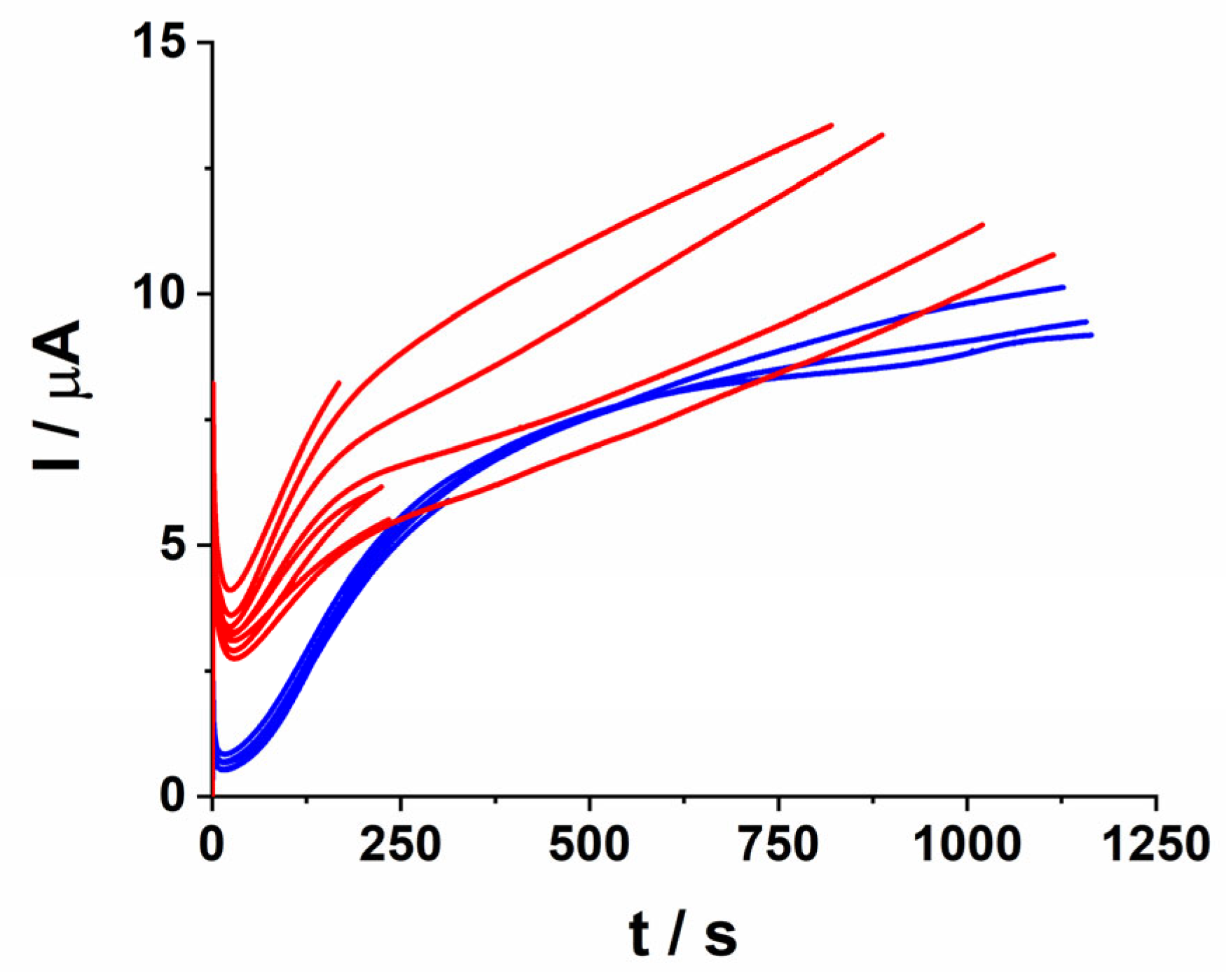

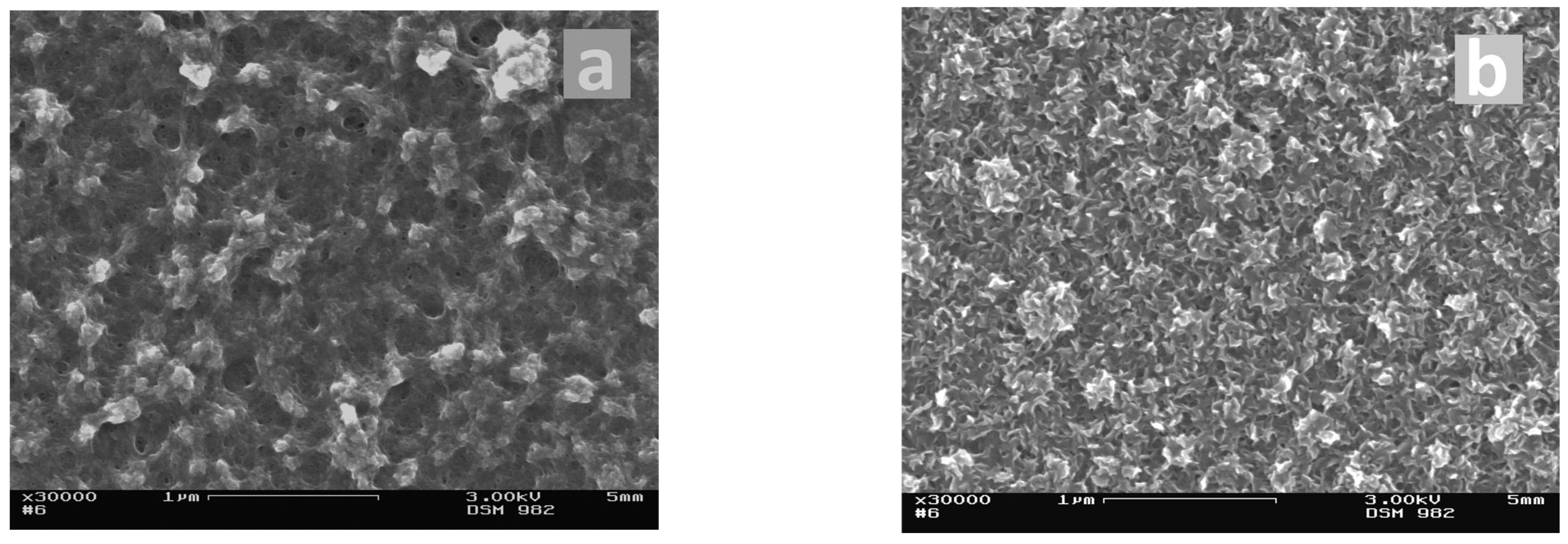
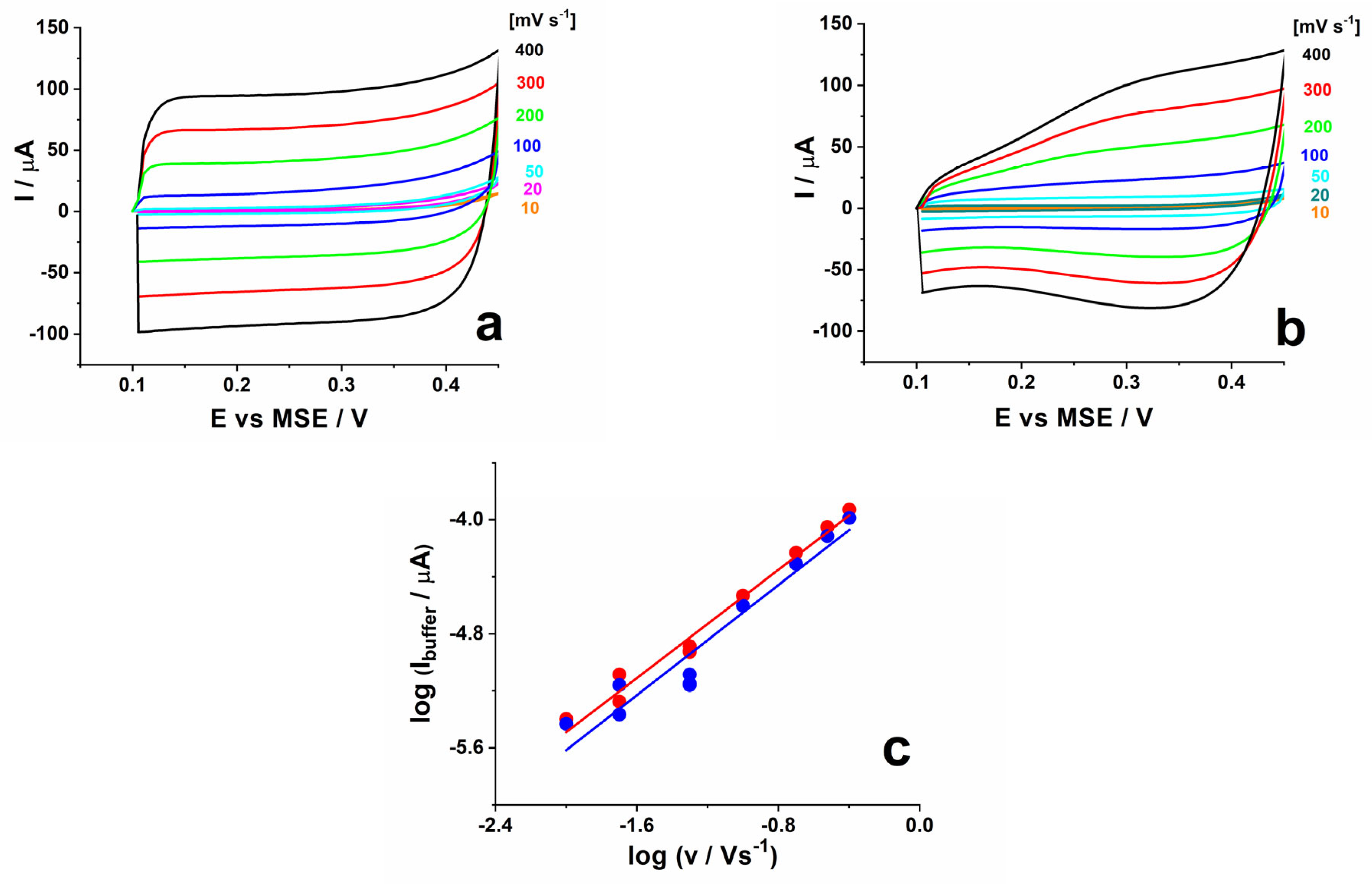
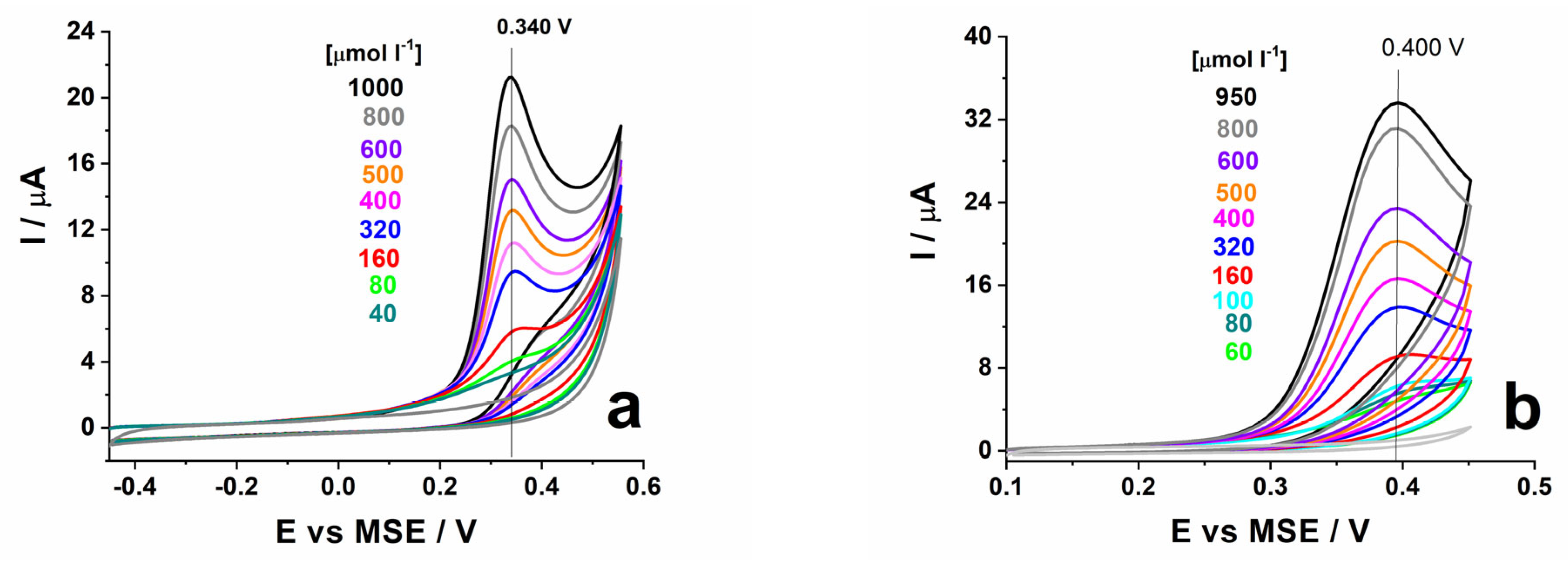
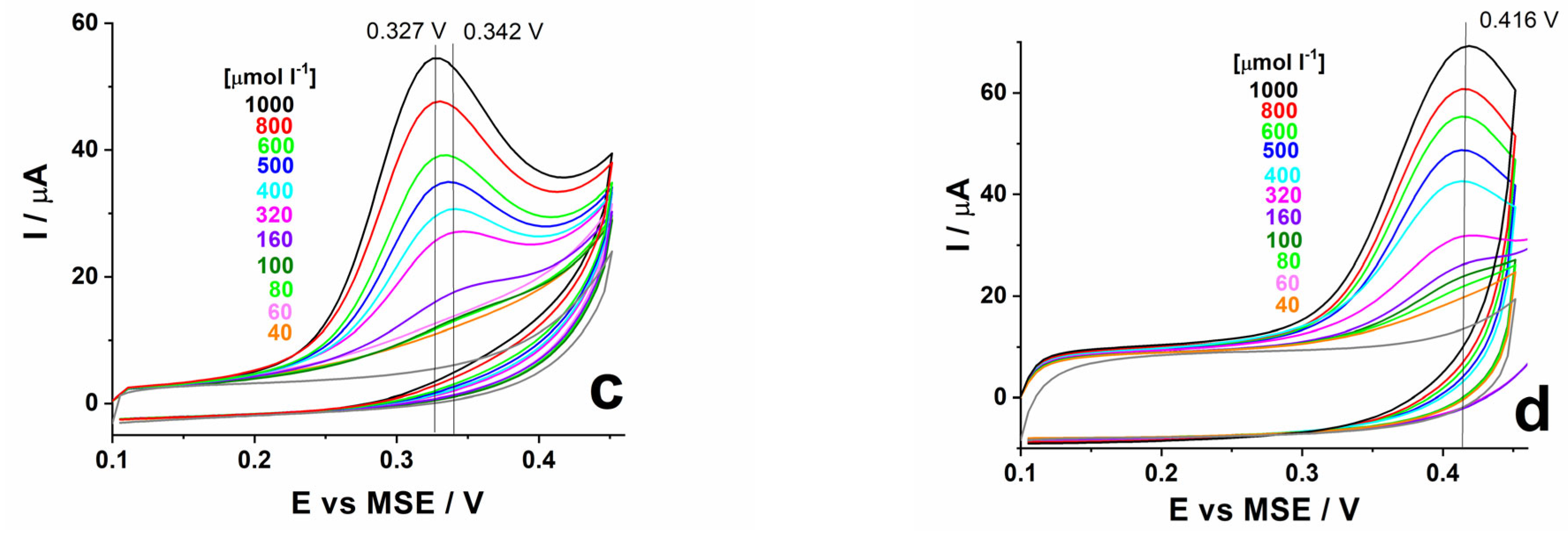


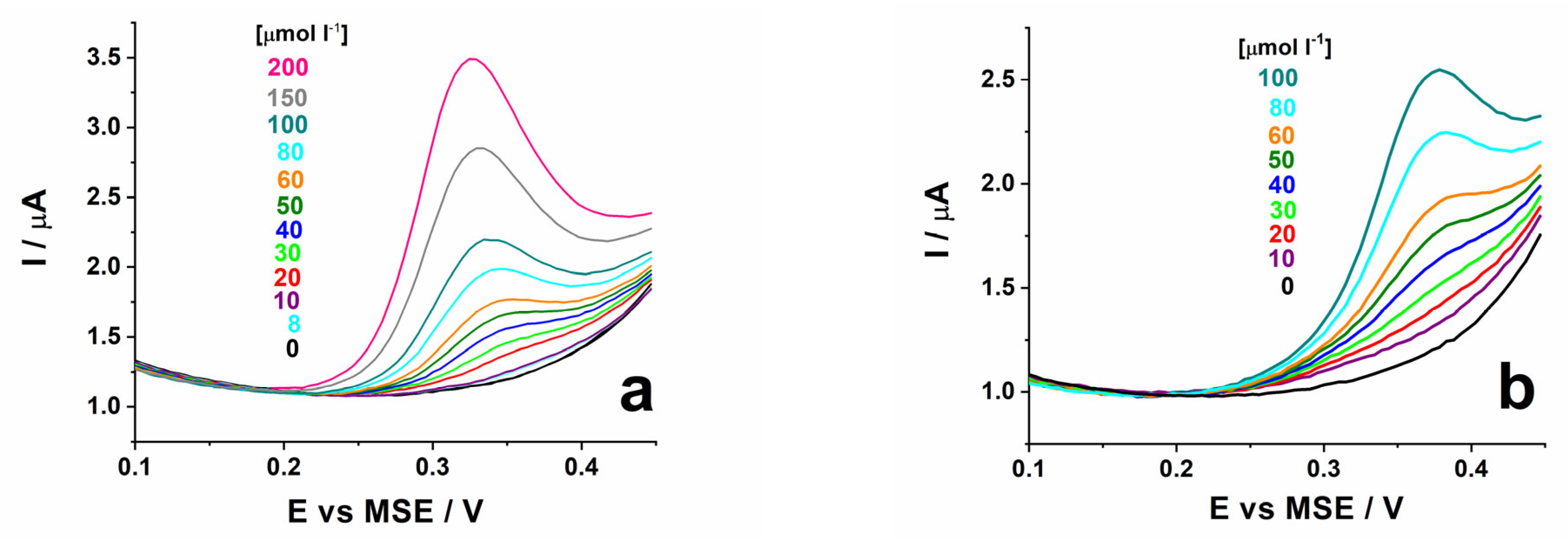
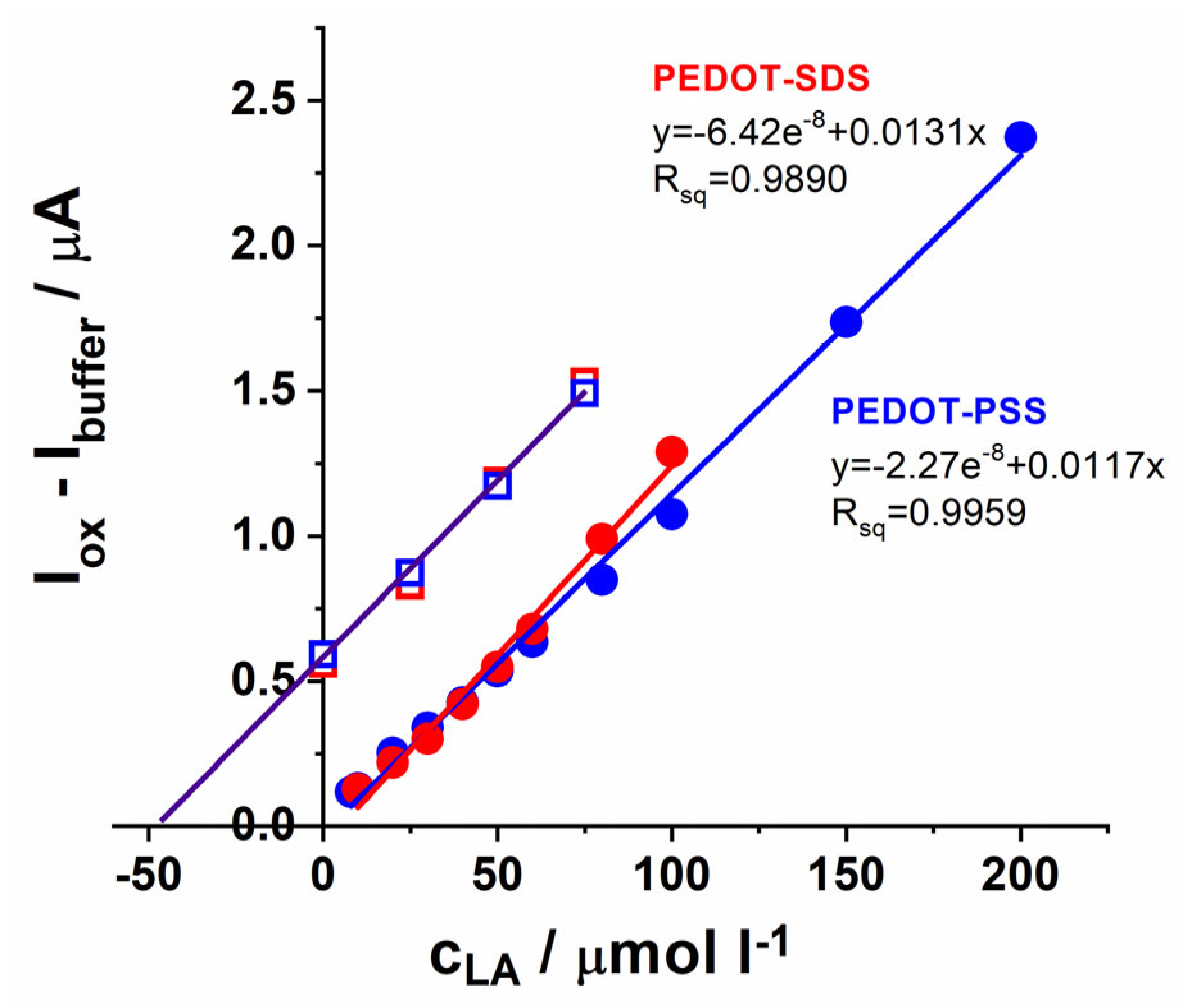
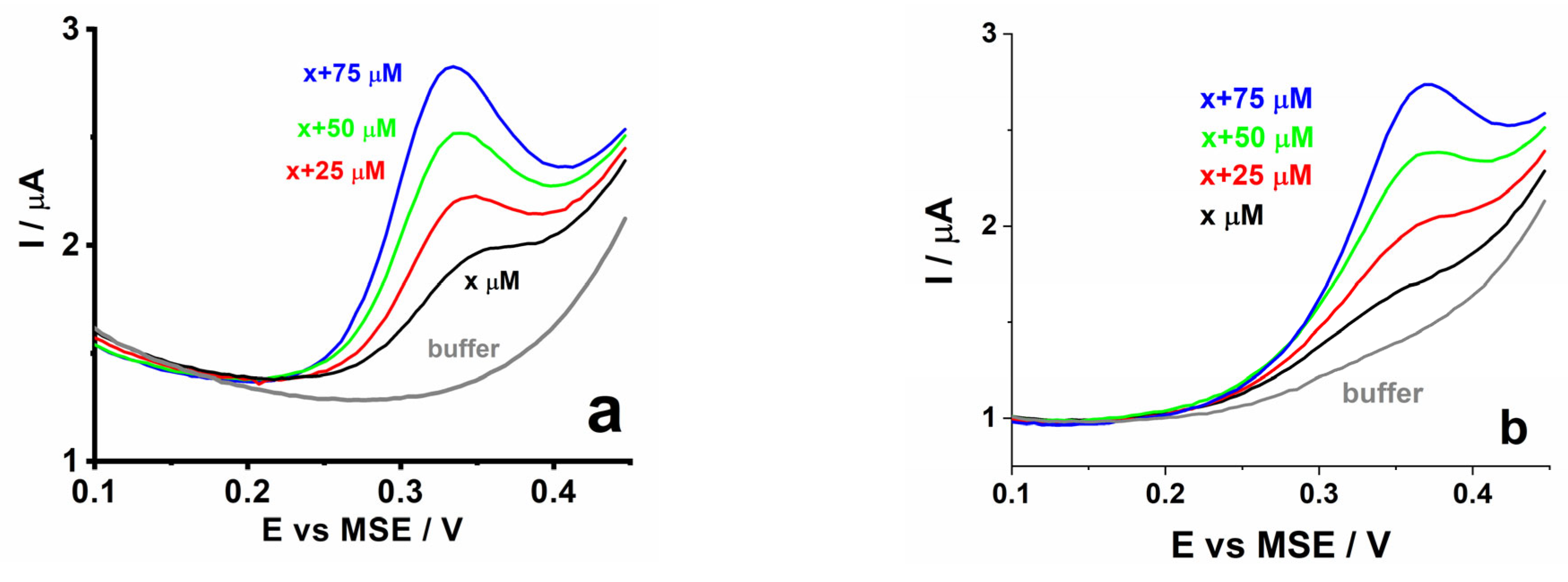
| Working Electrode | Electrolyte | Method | Linear Range [µM L−1] | LOD [µM L−1] | Reference |
|---|---|---|---|---|---|
| GCE | H2SO4 | LSV DPV | 1.51–173 2.5–75 | 5.75 1.8 | [18] |
| GCE | PBS | DPV | 1–150 | 1.8 | [19] |
| MWCNTs/GCE | H2SO4 | LSV | 26–180 * 210–780 | 19 | [23] |
| Co-phtalocynine/pyrolytic graphite | PBS | DPV CA CV | 0.499–19.6 1.9–25 7.3–260 | 0.0034 0.098 0.25 | [21] |
| B-doped diamond | BRB, pH3 | DPV CA | 0.3–105 0.3–60 | 0.088 0.06 | [22] |
| F-doped SnO2 | PBS | SWV | 5–200 | 3.7 | [24] |
| Pt | BRB, pH 4.5 | DPV | 10–800 | 13.15 | [25] |
| MWCNT/-polyindole/Ti2O3 | PBS | DPV | 0.39–110 | 0.0012 | [26] |
| SnO2 NPs-CTPPB/GCE | BRB, pH 4.5 | DPV | 0.5–50 * 50–400 | 0.13 0.43 | [27] |
| Method | Specimen | Concentration Range [µmol L−1] | Sensitivity [µA µmol−1 cm−2] | LOD [µmol L−1] |
|---|---|---|---|---|
| CV | PSS, 1 mC | 40–1000 | 0.233 | 50 |
| CV | SDS, 1 mC | 60–950 | 0.413 | 36 |
| CV | PSS, 8 mC | 100–1000 | 0.550 | 34 |
| CV | SDS, 8 mC | 100–750 | 0.876 | 40 |
| DPV | PSS, 1 mC | 8–200 | 0.146 | 6 |
| DPV | SDS, 1 mC, | 10–100 | 0.163 | 7 |
Disclaimer/Publisher’s Note: The statements, opinions and data contained in all publications are solely those of the individual author(s) and contributor(s) and not of MDPI and/or the editor(s). MDPI and/or the editor(s) disclaim responsibility for any injury to people or property resulting from any ideas, methods, instructions or products referred to in the content. |
© 2023 by the authors. Licensee MDPI, Basel, Switzerland. This article is an open access article distributed under the terms and conditions of the Creative Commons Attribution (CC BY) license (https://creativecommons.org/licenses/by/4.0/).
Share and Cite
Karabozhikova, V.; Tsakova, V. Electrochemically Obtained Poly(3,4-ethylenedioxythiophene) Layers for Electroanalytical Determination of Lipoic Acid. Coatings 2023, 13, 2014. https://doi.org/10.3390/coatings13122014
Karabozhikova V, Tsakova V. Electrochemically Obtained Poly(3,4-ethylenedioxythiophene) Layers for Electroanalytical Determination of Lipoic Acid. Coatings. 2023; 13(12):2014. https://doi.org/10.3390/coatings13122014
Chicago/Turabian StyleKarabozhikova, Vasilena, and Vessela Tsakova. 2023. "Electrochemically Obtained Poly(3,4-ethylenedioxythiophene) Layers for Electroanalytical Determination of Lipoic Acid" Coatings 13, no. 12: 2014. https://doi.org/10.3390/coatings13122014






